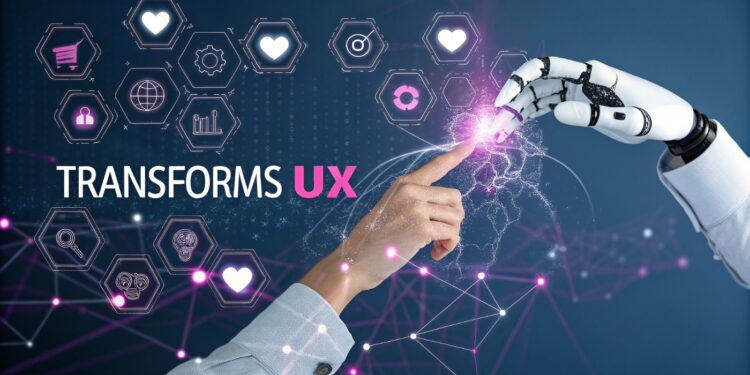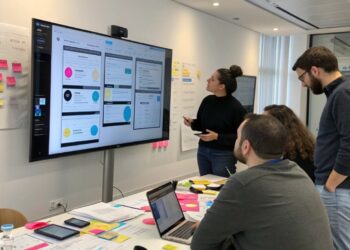Let’s talk about how AI for ux design is changing the way people build websites and apps. A long time ago, designers looked at what users did by hand. Now, with smart AI tools, designers can understand users super fast.
Because of AI for ux design, we can know what users like and don’t like more easily. We can design better things for them without guesswork. This blog shows you seven genius ways AI is making user experiences much better. You’ll learn how AI helps us from start to finish, from research to making things easier to use. And along the way, you might want to explore ux design courses, ux design bootcamp, or even General Assembly Bootcamp, Designlab UX Academy, or Interaction Design Foundation if you’d like to go deeper.
Understanding AI for ux design
What does AI for ux design mean? It’s when smart computer tools help designers make things easier and nicer for users. That could mean tools that look at what users click on, tools that help draw screens, or tools that test if things are easy to use.
These smart helpers fit into the UX process like this:
- Research: AI spots user problems and patterns fast.
- Planning: AI suggests what screens to design next.
- Design: AI helps make wireframes or clickable layouts.
- Testing: AI checks if users get stuck or confused.
- Improving: AI keeps watching and helps fix problems over time.
Using AI for ux design brings big wins:
- Super fast results (speed)
- Smarter choices (precision)
- Designs that fit each user (personalization)
- Tools that grow as you need them (scalability)
If you want to learn more, try looking at a springboard ux bootcamp or best ux design schools. Also, AI certifications can help you show you know how to use AI in design.
1. AI‑Driven User Research and Insights
First stop: research. With AI for ux design, AI studies what users do and finds patterns humans might miss.
AI does this by:
- Watching clicks, taps, and scrolls.
- Grouping users by what they do most.
- Spotting where users get stuck.
Tools like machine learning can show us, “Oh, users do this weird thing on screen three.” That’s a hidden pattern, and AI finds it quick.
For example, suppose you run an app. AI might show you that people always stop after one screen. That tells you to fix screen two fast. That’s a big help for UX designers. And you can learn more using ux design courses or a fun ux design bootcamp.
2. Smarter Personalization for Every User
Now, let’s talk about making things fit each person. AI for ux design can show users what they like and hide what they don’t.
Here’s how:
- Show different buttons or images to different users.
- Offer content based on what someone likes or clicked on before.
- Remember user habits and adjust the design.
Real example: A shopping app guesses what you want and shows items just for you. That feels helpful and fun.
That’s good for users because they see stuff they like quickly. It’s good for business too, it means higher engagement, happier users, and more return visits.
3. Intelligent Prototyping and Wireframing
On to prototyping! That’s making a simple version of your design. With AI for ux design, AI helps draw screen layouts and suggest buttons.
Some tools do this:
- Auto‑layout tools that place parts in the right place.
- Suggestions for colors or fonts that match your style.
- Quick fixes to make things look balanced.
Designers get to go faster. Instead of drawing each button by hand, AI can suggest a layout. The key is to let AI do the easy parts, and you add your own creativity. Want to learn how? Try Designlab UX Academy or springboard ux bootcamp for hands‑on help.
4. Predictive UX Through Data Modeling
AI also predicts what users will do next. That’s predictive UX.
This works by:
- Using past data to guess user moves.
- Showing content before someone asks.
- Finding where users will click or tap next.
Example: A news app predicts what story a reader will like, then shows it right away. That smooths the flow and reduces confusion.
This kind of help makes experiences feel smart. You stay one step ahead of your user. Tools like these are great, maybe your ux design bootcamp teaches them.
5. Enhancing Accessibility and Inclusivity
Everyone should be able to use designs easily. AI for ux design helps make things inclusive.
Here’s how:
- AI checks if button text is easy to read.
- AI checks if colors contrast enough for everyone.
- AI adds alt text for images automatically.
Case study: A website used AI to fix contrast issues and automatically added alt text. More people with vision issues could use it smoothly.
Smart AI tools help designers make things everyone can use, without even thinking twice. If you care about inclusive design, similar tools are covered in Interaction Design Foundation training.
6. Automating Repetitive UX Tasks
Some tasks are boring and repeated over and over. AI for ux design can do these tasks fast.
Tasks like:
- Naming colors and fonts.
- Checking if a button is aligned.
- Exporting assets for devs (like PNGs, icons).
When AI handles these, designers have more time to think, plan, and be creative.
That means more time to build awesome features and less time doing copy‑and‑paste. Plenty of ux design courses cover which tools help with that.
7. AI for Continuous UX Optimization
Last, AI keeps your design fresh. That’s continuous UX optimization.
How it works:
- AI watches user behavior all the time.
- It sends alerts when users struggle.
- It suggests small improvements often.
Like a website that changes a button color if users don’t click it enough. Then it keeps testing new colors until users click more.
This feedback loop helps designers improve bit by bit. Every day gets better. That’s powerful.
The Future of AI for ux design
What’s next for AI for ux design? Let’s peek ahead.
We’ll see new tools that:
- Use voice or gestures to design.
- Use Virtual Reality (VR) or Augmented Reality (AR) in UX.
- Mix human emotion with AI smarts.
Designers will still be storytellers and thinkers. AI will give us tools to make things faster and more human. It’s not robots taking over, it’s smart helpers making us better.
If you want to get ready for this future, check out General Assembly Bootcamp or Interaction Design Foundation. They teach future‑ready skills.
Conclusion
So there you go, seven genius ways AI for ux design transforms everything designers do, from research to real‑time optimization.
- AI speeds up research and finds patterns.
- It personalizes each user’s experience.
- It helps draw fast prototypes.
- It predicts what users want next.
- It makes designs inclusive.
- It automates boring tasks.
- It keeps improving your design every day.
Combining your creativity with AI tools gives you the best of both worlds, human insight and smart speed.
Want to level up your skills? Take the next step: explore a ux design bootcamp, enroll in ux design courses, or try ai certifications. You’ll be ready to make smarter, more delightful user experiences, faster than ever.
Start using AI today and watch your designs shine!









